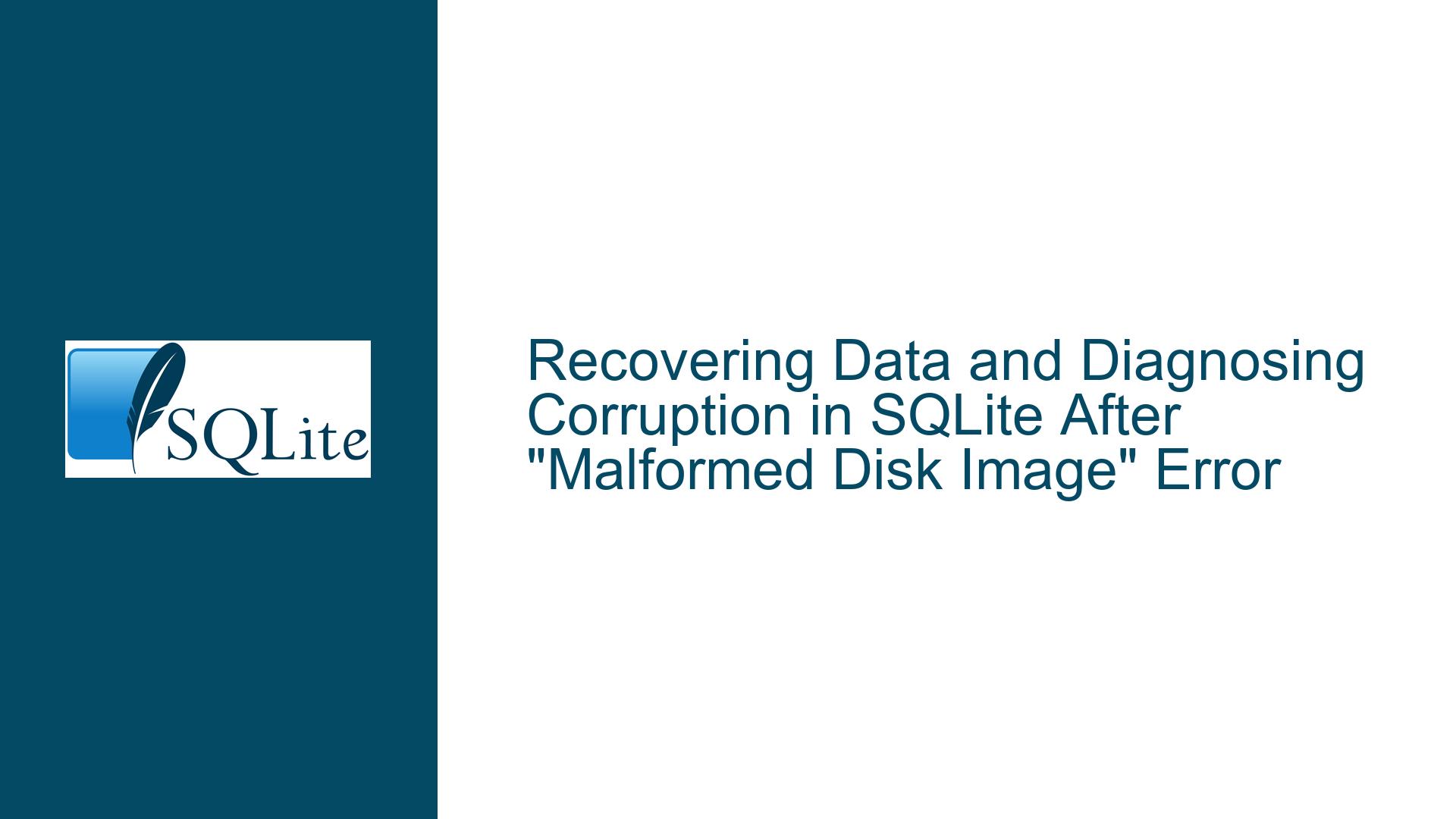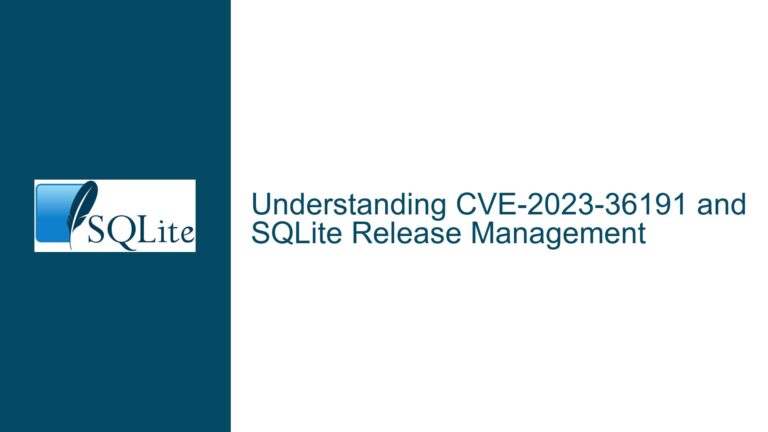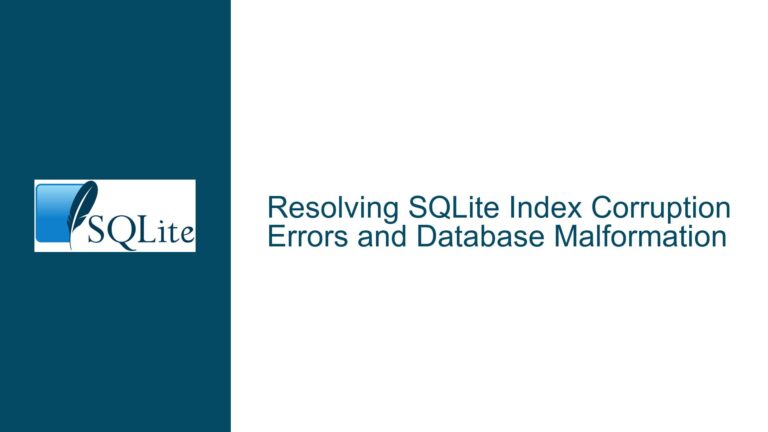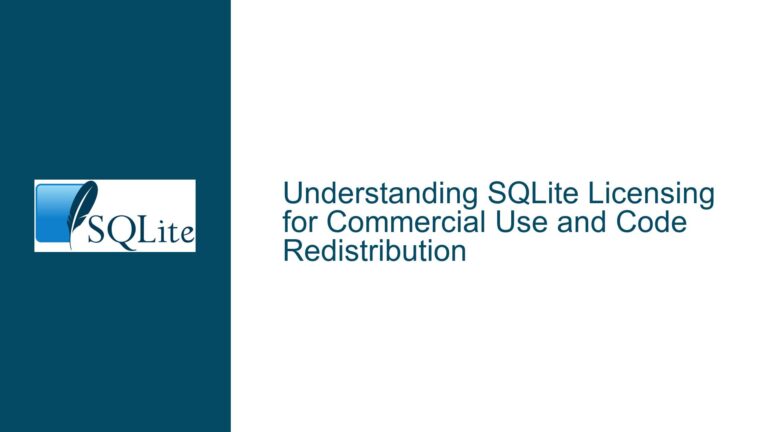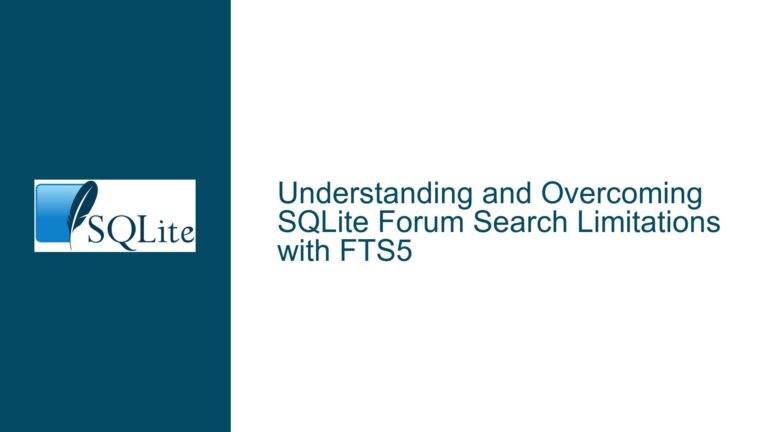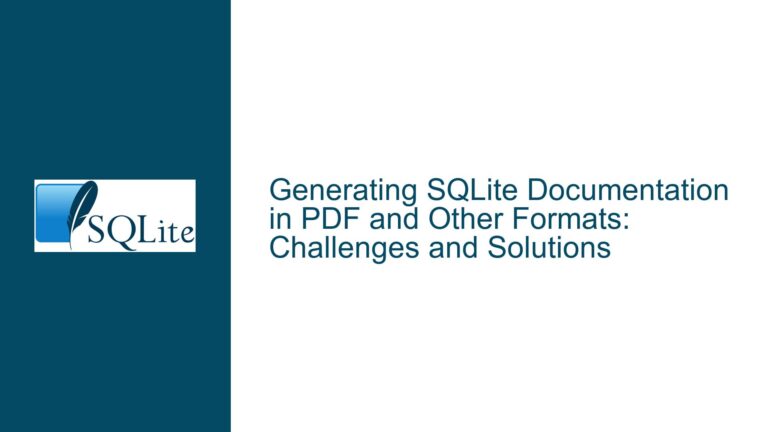Recovering Data and Diagnosing Corruption in SQLite After “Malformed Disk Image” Error
Understanding SQLite Database Corruption and Recovery Feasibility
The "database disk image is malformed" error in SQLite indicates structural corruption within the database file. This error arises when SQLite’s internal consistency checks detect anomalies in the database’s storage format, such as invalid page headers, mismatched cell pointers, or broken b-tree structures. Corruption can occur at various levels: individual pages, tables, indices, or the entire file. The severity of the corruption determines whether partial or full recovery is possible.
SQLite databases are designed with robustness in mind, employing mechanisms like atomic commits, write-ahead logging (WAL), and checksums to minimize corruption risks. However, external factors such as hardware faults, abrupt process termination, filesystem errors, or software bugs can bypass these safeguards. When corruption occurs, SQLite’s error handling shifts into a defensive posture: it aborts the current operation and prevents further access until the issue is resolved.
Recovery feasibility hinges on two factors: the scope of corruption (e.g., a single table vs. critical system tables) and the availability of redundant data (e.g., backups, WAL files). In many cases, SQLite’s .recover command or third-party tools can reconstruct a functional database by salvaging intact data and bypassing corrupted regions. However, if critical structural pages (like the sqlite_schema table) are damaged, full recovery may require manual intervention or reliance on backups.
Common Causes of SQLite Database Corruption
1. Hardware or Storage Layer Failures
Storage devices with failing sectors, faulty memory modules, or disconnected drives during write operations can corrupt database files. For example, if a power outage interrupts a page write, the database may end up with partially written pages or mismatched journal/WAL entries.
2. Filesystem Inconsistencies
Filesystem bugs, improper mounting (e.g., read-only mounts with write operations), or misconfigured network storage (NFS without stable writes) can lead to incomplete writes. SQLite relies on the filesystem to honor fsync() calls; if these are ignored or delayed, journal and WAL files may desynchronize from the main database.
3. Application-Level Bugs
Incorrect use of SQLite APIs—such as closing database connections during active transactions, concurrent writes without proper locking, or mishandling of temporary files—can leave the database in an inconsistent state. ADO.NET-specific issues might include improper disposal of SQLiteConnection objects or misconfigured transaction scopes.
4. Antivirus or Security Software Interference
Overly aggressive file scanners may lock or quarantine the database file during scans, disrupting SQLite’s access patterns. This is especially problematic when such software holds locks on the WAL or shared memory files (-shm, -wal).
5. File Copying or Backup Errors
Copying an open database file without using SQLite’s backup API can result in an inconsistent snapshot. For instance, using File.Copy() in .NET on a live database file may capture a mid-transaction state.
6. SQLite Version Mismatches
Using an older SQLite library to open a database created with a newer version (or vice versa) can trigger compatibility issues, especially if the newer version uses features like stricter schema validation or enhanced page formats.
Step-by-Step Recovery and Repair Strategies for Corrupt SQLite Databases
1. Assess Corruption Scope with PRAGMA integrity_check
Open the SQLite CLI or a tool like DB Browser for SQLite and execute:
PRAGMA integrity_check;
This command scans the database for structural anomalies and returns a list of errors. If the output is anything other than ok, note the specific page numbers or table names mentioned. For example, errors like row missing from index or invalid page type indicate localized corruption.
2. Use the .recover Command to Reconstruct Data
The .recover CLI command attempts to rebuild the database by extracting data from intact pages and bypassing corrupted regions. Execute:
sqlite3 corrupt.db ".recover" | sqlite3 recovered.db
This pipes the recovered SQL schema and data into a new database. Inspect recovered.db for completeness. Note that .recover may fail if system tables are damaged.
3. Extract Data via Dump and Reimport
If .recover is insufficient, manually dump the database:
sqlite3 corrupt.db .dump > backup.sql
Edit backup.sql to remove corrupted sections (e.g., INSERT statements referencing corrupt tables), then reimport:
sqlite3 new.db < backup.sql
4. Leverage WAL and Rollback Journals
If the database uses WAL mode, check for -wal and -shm files. Copy these alongside the main database to a safe location. Use sqlite3 wal_autocheckpoint=0; to disable automatic checkpointing, then attempt to open the database and dump data.
5. Employ Third-Party Recovery Tools
Tools like SQLite Database Recovery (stellarinfo.com) or SysTools SQLite Recovery scan the file at a binary level, extracting recoverable records. These tools are particularly useful when SQLite’s built-in methods fail.
6. Restore from Backups
If backups exist (e.g., daily snapshots or incremental copies), replace the corrupt database with the most recent backup. Use the .clone or .backup CLI commands for future backups to ensure consistency.
7. Address ADO.NET-Specific Issues
For ADO.NET applications, ensure:
SQLiteConnectionobjects are wrapped inusingblocks.- Transactions are correctly committed or rolled back.
- Write-ahead logging is enabled with
PRAGMA journal_mode=WAL;to reduce contention. - The
Synchronouspragma is set toFULLfor critical data integrity.
8. Prevent Future Corruption
- Regularly validate databases with
PRAGMA quick_check. - Use battery-backed storage or UPS systems to avoid power-related corruption.
- Test filesystem reliability with
PRAGMA cell_size_check=ON. - Avoid exposing SQLite files to network filesystems; opt for server-based databases like PostgreSQL for networked environments.
9. Manual Binary Repair (Last Resort)
Hex editors or custom scripts can repair specific page errors if the corruption is minimal. For example, resetting a page’s header to match SQLite’s format (byte offset 16: 0x0D for leaf table pages). This requires deep knowledge of SQLite’s file format and is error-prone.
In cases where all recovery attempts fail, consider sending the database file to SQLite’s developers for analysis—they may provide insights or patches to improve future robustness. Always prioritize prevention through rigorous testing, proper transaction handling, and reliable backup strategies.
